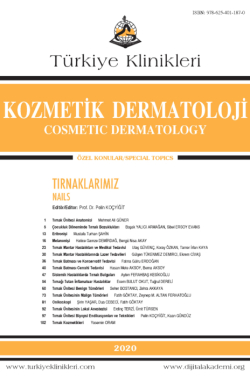Erythronychia
Mustafa Turhan ŞAHİNa
aManisa Celal Bayar Üniversitesi Tıp Fakültesi, Deri ve Zührevi Hastalıkları ABD, Manisa, TÜRKİYE
Şahin MT. Eritronişi. Koçyiğit P, editör. Tırnaklarımız. 1. Baskı. Ankara: Türkiye Klinikleri; 2020. p.13-5.
ABSTRACT
Erythronychia is a term that covers a range of pathological patterns of red discoloration of the subungual tissues. The intensity of the red contrasts with the pale pink of the nail bed or the cream color of the lunula. It is typically due to one or more actors that include inflammation, vessel proliferation, and engorgement and focal thinning of the nail plate. Longitudinal erythronychia presents with longitudinal red bands in the nail plate that commence in the matrix and extend to the point of separation of the nail plate and nailbed. Neoplastic, inflammatory, scarring, or idiopathic processes involve the distal nail matrix, producing a groove in the ventral nail plate. The nail bed then occupies this groove and accentuates the red color of the nail bed, producing a red streak. Longitudinal erythronychia may be specific to one nail or involve multiple nails.When longitudinal erythronychia involves one nail, it may be caused by benign conditions, such as onychopapilloma, wart, warty dyskeratoma, glomus tumor, or a solitary lesion of lichen planus. Less commonly, it may be caused by malignancies, such as Bowen disease, invasive squamous cell cancer, melanoma in situ, and basal cell carcinoma. The most common causes of longitudinal erythronychia involving multiple nails are lichen planus and Darier disease. Less common etiologies are systemic amyloidosis, hemiplegia, graft-versus-host disease, and acantholytic epidermolysis bullosa.
Keywords: Erythronychia; red discoloration; red band
Kaynak Göster
Referanslar
- David de Berker. Erythonychia. Dermatologic Therapy. 2012; 25: 603-11. [Crossref] [PubMed]
- Jellinek NJ. longitudinal erythronychia: suggestions for evaluation and management. J Am Acad Dermatol. 2011; 64: 167.e1-167. [Crossref] [PubMed]
- de Berker DA, Perrin C, Baran R. localized longitudinal erythronychia: diagnostic significance and physical explanation. Arch Dermatol. 2004; 140: 1253-7. [Crossref] [PubMed]
- Baran R, Perrin C. longitudinal erythronychia with distal subungual keratosis: onychopapilloma of the nail bed and Bowen's disease. Br J Dermatol. 2000; 143: 132-5. [Crossref] [PubMed]
- Dalle S, Depape l, Phan A, Balme B, RongerSavle S, Thomas l. Squamous cell carcinoma of the nail apparatus: clinicopathological study of 35 cases. Br J Dermatol. 2007;156: 871-4. [Crossref] [PubMed]
- Harwood M, Telang gH, Robinson-Bostom l, Jellinek N. Melanoma and squamous cell carcinoma on different nails of the same hand. J Am Acad Dermatol. 2008; 58:323-6. [Crossref] [PubMed]
- Palencia Sı, Rodriguez-Peralto Jl, Castano E, Vanaclocha F, ıglesias l. lichenoid nail changes as sole external manifestation of graft versus host disease. ınt J Dermatol. 2002; 41: 44-5. [Crossref] [PubMed]
- Burge SM. Hailey-Hailey disease: the clinical features, response to treatment and prognosis. Br J Dermatol. 1992; 126: 275-82. [Crossref] [PubMed]
- Cooper SM, Burge SM. Darier's disease: epidemiology, pathophysiology, and management. Am J Clin Dermatol. 2003; 4: 97-105. [Crossref] [PubMed]
- Criscione V, Telang g, Jellinek NJ. onychopapilloma presenting as longitudinal leukonychia. J Am Acad Dermatol. 2010; 63: 541-2. [Crossref] [PubMed]
- de Berker D, goettman S, Baran R. Subungual myxoid cysts: clinical manifestations and response to therapy. J Am Acad Dermatol 2002; 46: 394-8. [Crossref] [PubMed]
- Roldan-Marin R, Dominguez-Cherit J, VegaMemije ME, Toussaint-Caire S, Hojyo-Tomoka MT, Dominguez-Soto l. Solitary subungual neurofibroma: an uncommon finding and a review of the literature. J Drugs Dermatol. 2006: 5: 672-4.
- Richert B, di Chiacchio N, Haneke E. Nail surgery, 1st ed. london: ınforma. 2010. [Crossref]
- Roan Tl, Chen CK, Horng SY, et al. Surgical technique innovation for the excision of subungual glomus tumors. Dermatol Surg. 2011;37: 259-62. [Crossref] [PubMed]
- Piraccini BM, Saccani E, Starace M, Balestri R, Tosti A. Nail lichen planus: response to treatment and long term follow- up. Eur J Dermatol. 2010; 20: 489-96. [Crossref] [PubMed]
- Tunc SE, Ertam ı, Pirildar T, Turk T, ozturk M, Doganavsargil E. Nail changes in connective tissue diseases: do nail changes provide clues for the diagnosis? J Eur Acad Dermatol Venereol. 2007; 21: 497-503. [Crossref] [PubMed]
- Wollina u, Barta u, uhlemann C, oelzner P. lupus erythematosus-associated red lunula. J Am Acad Dermatol. 1999; 41: 419-21. [Crossref] [PubMed]
- Lesher Jl Jr, Peterson CM, lane JE. An unusual case of factitious onychodystrophy. Pediatr Dermatol. 2004; 21: 239-41. [Crossref] [PubMed]
- ghetti E, Pirrachini BM, Tosti A. onycholysis and subungual haemorrhages secondary to systemic chemotherapy (paclitaxel). J Eur Acad Dermatol Venereol. 2003; 17: 459-60. [Crossref] [PubMed]
- Sanchez-Re ́ gana M, Sola- ̃ ortigosa J, Alsina-gibert M, Vidal- Fernández M, umbert-Millet P. Nail psoriasis: a retrospective study on the effectiveness of systemic treatments (classical and biological therapy). J Eur Acad Dermatol Venereol. 2011; 25: 579-86. [Crossref] [PubMed]
- de Berker D. Management of psoriatic nail disease. Semin Cutan Med Surg. 2009; 28: 39-43. [Crossref] [PubMed]

